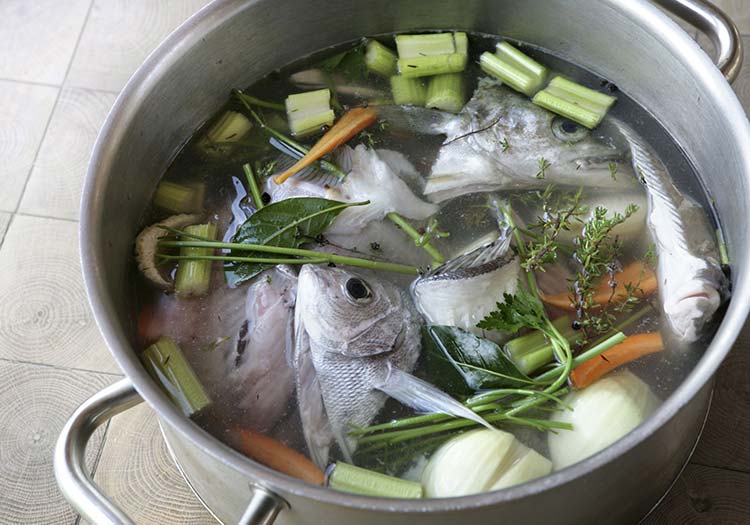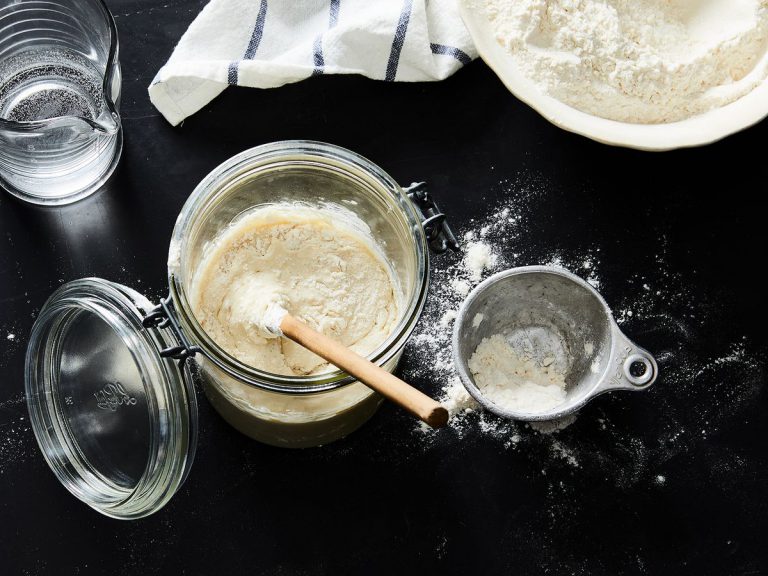French Baguette Recipe: Professor of Breads
Sourdough Starter (Polish) 250g organic wheat flour (high protein value) 200ml cold water 4g instant dry yeast Ingredients 250 g organic wheat flour (high protein value) 160 ml water (at room temperature) 12 g (sea) salt 3.5 g instant dry yeast 3 g fresh yeast 25 g flower honey Nothing like a freshly baked sourdough…
Sourdough Starter (Polish)
- 250g organic wheat flour (high protein value)
- 200ml cold water
- 4g instant dry yeast
Ingredients
- 250 g organic wheat flour (high protein value)
- 160 ml water (at room temperature)
- 12 g (sea) salt
- 3.5 g instant dry yeast
- 3 g fresh yeast
- 25 g flower honey
Nothing like a freshly baked sourdough French baguette on Sunday morning. It’s crispy on the outside and delicious, with plenty of holes and warm inside, wouldn’t it be great with a little butter on it? One of the most popular simple breakfast foods, the duo of bread and pure butter.
Baguette making requires really tricky skills. If you can’t do it at first, don’t give up trying, every time you do, you will discover new problems and gradually master them. His first experience of baking bread is 2-3. we guarantee that you will not believe the experience you have really gone after the trial. The most important issue will be the taste and how your baguette will look, let’s start to explain the factors that affect them.
What is Hydration (Polish)?
Hydration means the liquid contained in the dough for bread making. We will briefly explain delayed fermentation in two parts in bread making and what the liquid level means. The more liquid the dough contains and the slower its fermentation occurs, the smoother the gluten bonds in the bread begin to form and it is the formation of that wonderful perforated structure in your bread.
So how is hydration calculated; Let’s always explain as follows when calculating. Forget the percentages you learned in school, think of it as a simple ratio. Generally, all bread doughs consist of flour, water (liquid), salt and yeast. According to the values we give as a percentage in the example below… Take the value of the flour that you will use as the base value as 100% and form the weight of the other values according to the value of the flour. Since we will make the hydration 90% in this recipe
| Flour (100%) | Water (90%) | Salt (3%) | Yeast (1.5%) |
|---|---|---|---|
| 500 gr | 450 ml | 15 gr | 7.5 gr |
How to Make French Baguettes?
A traditional French baguette is made from flour, water, yeast and salt. It’s really fascinating how these four simple ingredients turn into a beautiful, tasty, crunchy baguette. What’s even more fascinating is that by playing with the proportions of different bakers using the same ingredients, they can produce quite different baguettes.
Until about a century ago, making naturally leavened bread was a firm rule for bakers in France. Later, this mixture turned into a mixture of natural yeast and baker’s yeast. Recently, many bakeries are starting to use ready-made yeasts in terms of efficiency because producing and using natural yeast requires much more labor and work.
Factors Affecting Sourdough Baguette Bread’s Taste and Appearance:
As mentioned above, many French baguettes are made with the same ingredients and differ in appearance and taste. This is largely due to the process and rates used. You can make the dough rise very quickly by using warm water and warm ambient temperature, but the taste will not be very good. Slowing down the fermentation process, known as cold retarding, will add complex flavors and enhanced aromas to your bread. So let’s see how you ferment the dough, how long you retard it, how and how much polish you use, how you fold it, shape it, and bake it – all this is how it affects the final product and contributes to the taste of your bread.
Baguette Bread Making Process
This baguette recipe uses baker’s yeast and is influenced by the method used by Anis Bouabsa, who won the 2008 Best Baguette competition in Paris. In an interview, Anis talked about baguette dough with 75% hydration (ie the ratio of water to flour), very little yeast, very little kneading, folded three times an hour and kept in the refrigerator for 21 hours. He also added that baguettes do not rise exactly when they are placed in the oven, it is the wet dough and very hot oven (480°F) that make the baguettes take up their volume.
Transformation Inside Bread
Flour used in this recipe is a multi-purpose standard flour, water, yeast and salt, which are widely used in baguette making among home baking enthusiasts, as well as a little tip for you: if you add a little flower honey to the dough mixture, browning will be extra during the Maillard reaction. It will add a darkness and give a sweetness to your baguette.
Extra Equipment
If you ask what is the necessary piece of equipment to make a delicious baguette, all I can say is the oven and the oven stone. Kneading your bread by hand is the easiest task. The best choice is to buy a large, and more importantly, thick heat-retaining baking stone. It doesn’t crack easily and provides a much better oven heat balance for your drum sticks. An even better solution is the pottery and its deep lid, which you can find in pottery stores. Another equipment is cast iron pots with lids to bake bread, you can choose for equal and balanced cooking in cooking, of course, if you use pot, your bread will not be French baguette and it will be a standard sourdough bread.

Straw and Sour Yeast Baguette Bread Making
- Mix all the ingredients in a bowl, cover with cling film and let rest for 15 minutes.
- For a period of 1 1/2 hours, turn the dough over after each set and make 3 sets of stretch and fold.
- Cover the bowl with plastic wrap and put it in the fridge overnight for about 12-14 hours.
- Turn the dough on a lightly floured work surface. Divide it into 3 equal parts and shape them into rectangles. Cover and rest for 45-60 minutes.
- Preheat the oven with a baking stone placed in the upper half of the oven and a bread pan filled with hot water on the lower rack.
- Gently each rectangle of dough. stretch it and fold it into a roller, closing the seams. Using your hands, roll the rollers to the desired length, approximately 14-15 inches, slightly stretching.
- Place it on a lightly floured sofa, seam side up. Cover and bake at room temperature for about 30-60 minutes or until the dough is stable enough.
- Transfer the baguettes onto a piece of parchment paper, seam side down and dust off the excess flour. Using a loaf of bread, a sharp knife, or a razor blade, make 3 points for each baguette. When scoring, use a quick and firm motion to ensure beautiful, clean cuts.
- Open the oven and slide the drumsticks onto the baking stone, being careful not to burn in the steam. Turn off the oven and lower the temperature to 475°F (245°C). Cook for 15 minutes.
- Remove the water pan, rotate the drumsticks, lower the temperature to 113°F (45°C) and continue cooking for another 15 minutes or until dark brown.






